Inspirations: Q & A with artists from Physique
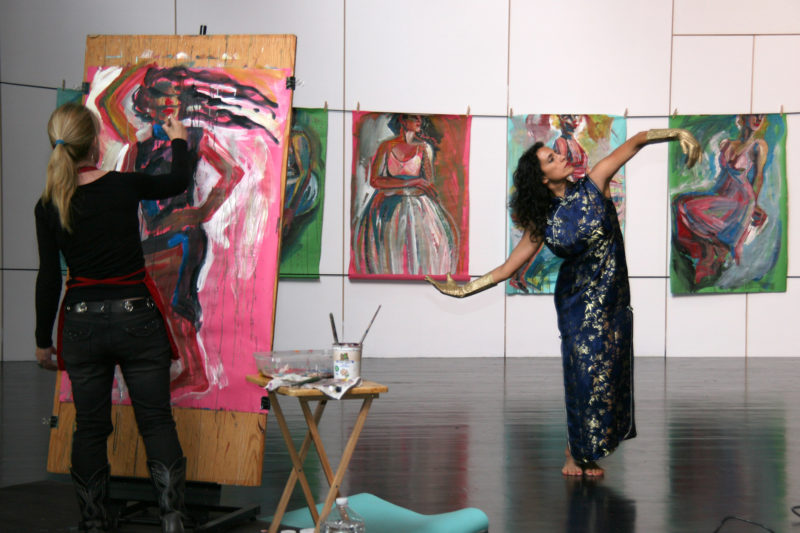
The human figure has been a source of artistic expression throughout history. Sparks Gallery posed the question “Why do you choose to explore the human form in your work?” to our local artists on view in our current group show, “Physique“.
Anna Stump: “My interest in the body/nude stems from my background as a dancer (ballet, modern, and ballroom). I’m interested in how the body functions in space, and how to define it within the edges of the spacial plane. I also love to work from life, and consider each painting a collaboration between the model and myself.” – Stump
Anna Van Fleet: “‘Victoria’s Lotus’ was big inspiration to me, I wanted to paint a nude girl in a way that her body will be a piece of art itself. I exaggerated the colors of tattoos against her white skin on the dark background, to make the image very contrast and vivid. I love to make my work with a lot of volume in it.” – Van Fleet
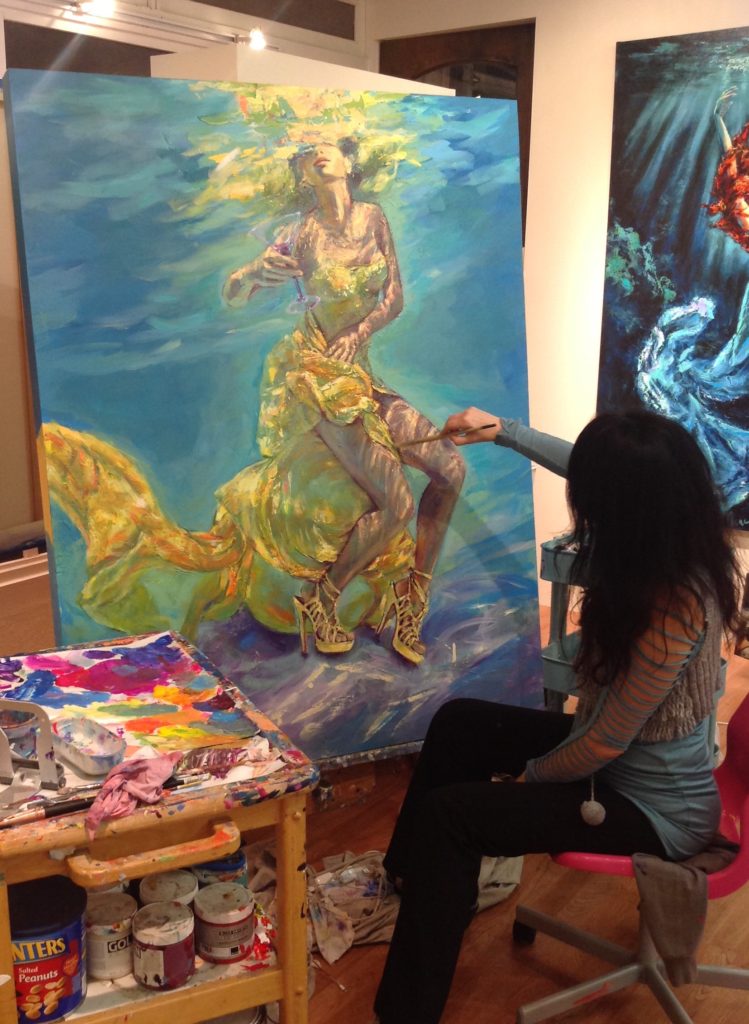
Irina Negulescu at work
Irina Negulescu: “I didn’t really choose it per say, as much as chance made the human form the foundation of my art experience. It was the time, the place, and the circumstances that gave me not much choice, forcing me to explore it and later love it. Many years ago when I was taking painting classes in Romania, the school couldn’t afford models. When they could afford them, the models would refuse to pose nude because it was too cold – the electricity was cut off at certain hours of the day to save energy during the harsh Communist years. So the teacher had an idea of having us taking turns posing as models. After hours of us drawing and painting our fully dressed classmates, the teacher would say “now undress her with your eyes and think what is hiding under all those clothes. If you can paint the female figure, you can paint anything you want”. Even though it was very funny in the beginning, I started with time to take it as a challenge and to be very serious about it. It was very difficult and it took much practice. Later on, having a younger sister, I had her pose for me in a lot of my drawing and paintings, and then over time, friends would offer to pose for free just to be in one of my paintings.” – Negulescu
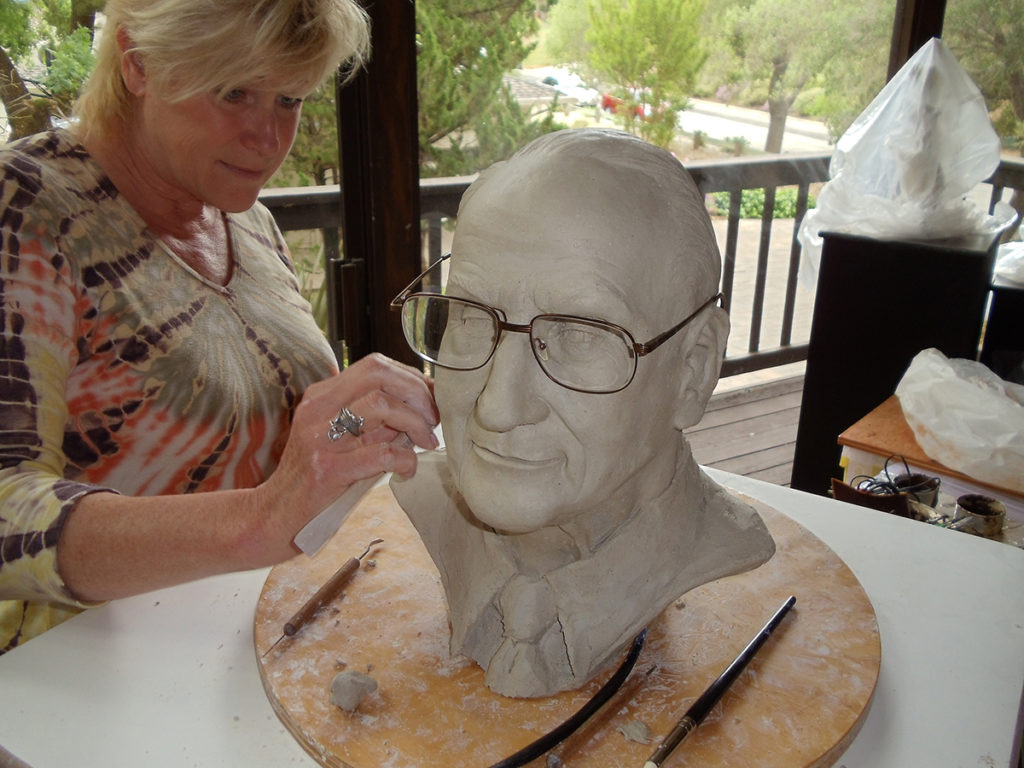
Julia S. Rasor sculpting bust of Ned S. Rasor
Julia Rasor: “Figurative sculpture satisfies an intense drive to connect through the ‘people’ I create. I am drawn to the vast expressive possibilities the human figure elicits and explore a continuum of styles from representational ‘natural’ to abstract ‘mechanical’ figures. In creating my art, I allow my feeling at the time, and the particular medium, lead my exploration into forms that inspire, provide a feeling or message, or just cause curious wonderment. Most of my life has been spent exploring technical ways to aid the human body; my art allows me to explore and express human emotion”. – Rasor
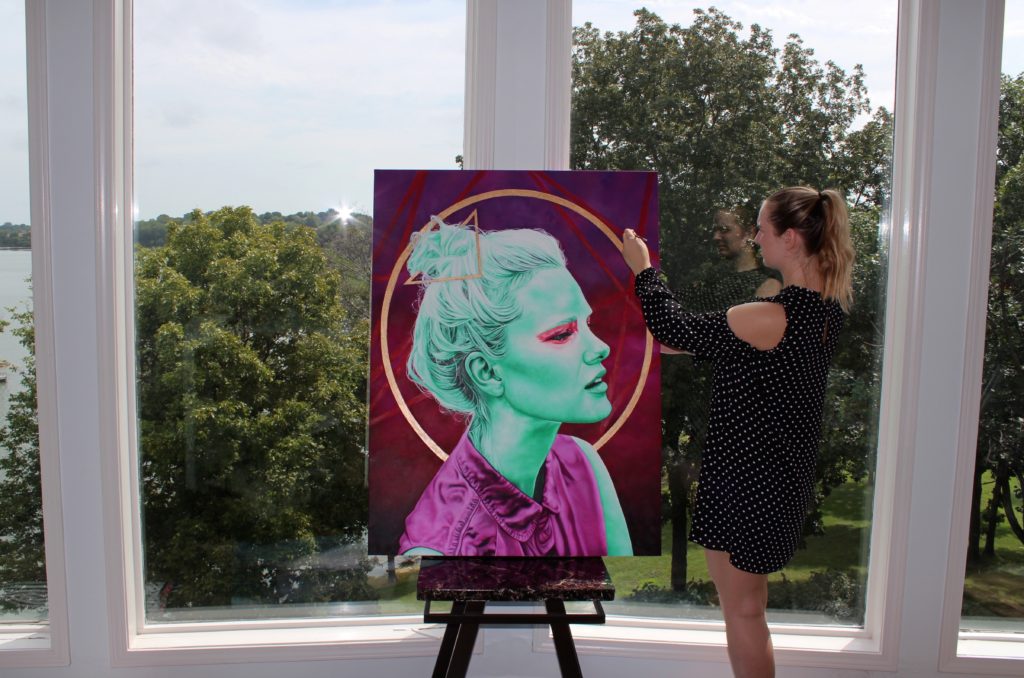
Kristen Reichert at work
Kristen Reichert: “I paint the human form because I feel it helps me to explore and capture those fleeting moments of innate beauty that we so rarely see in the world. In painting the form, my aim is to create a dialogue that examines the complex paradigms and relationships that surround us as human beings.” – Reichert
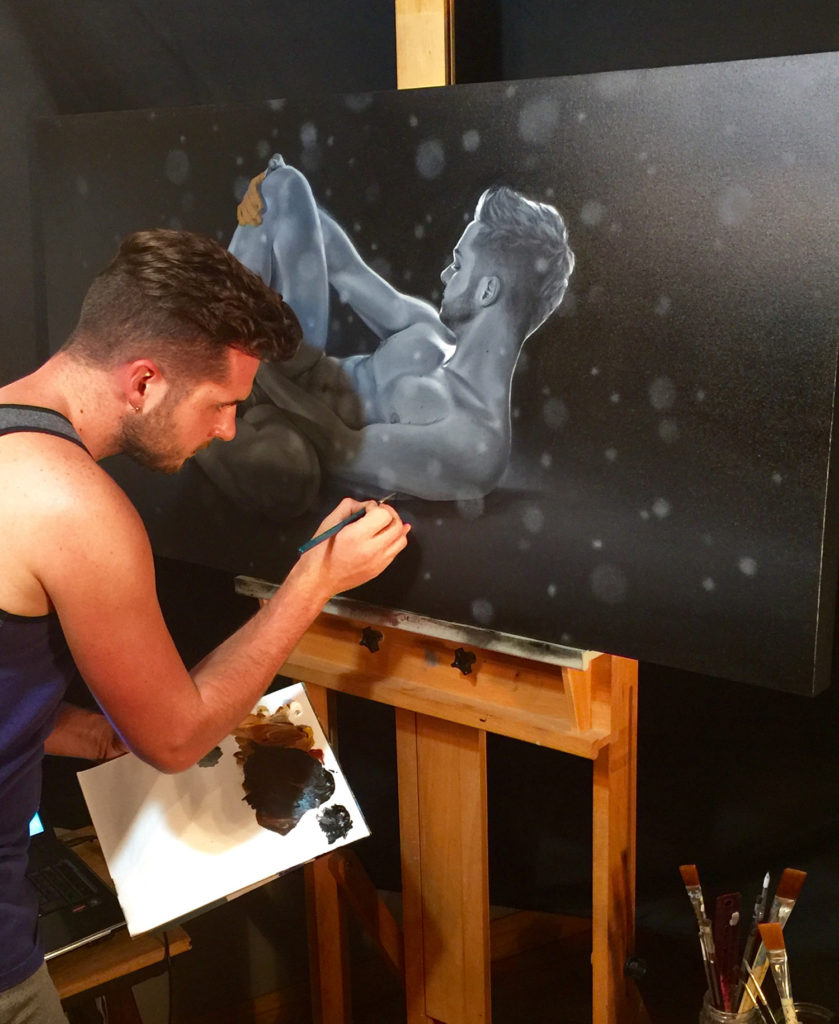 Kyle Trudelle: “I believe that we as human beings are the most intricate and fascinating aspect of creation. According to the biblical account of creation, all things were designed by the creator’s spoken word. “Let there be… And it was” save one aspect, mankind. Humans were the only part of creation formed by the very hands of the creator. The account also states that mankind was formed in the very image of God. This has intrigued me since I was a child. So as a creator myself, I have always pursued the human form. If it is the image of God, and if it was the only aspect of creation formed by the hands of this God, then I desire to master its image and expression to the best of my ability. The creator so obsessively expresses love for mankind, so there must be something undeniably special about us.” – Trudelle
Kyle Trudelle: “I believe that we as human beings are the most intricate and fascinating aspect of creation. According to the biblical account of creation, all things were designed by the creator’s spoken word. “Let there be… And it was” save one aspect, mankind. Humans were the only part of creation formed by the very hands of the creator. The account also states that mankind was formed in the very image of God. This has intrigued me since I was a child. So as a creator myself, I have always pursued the human form. If it is the image of God, and if it was the only aspect of creation formed by the hands of this God, then I desire to master its image and expression to the best of my ability. The creator so obsessively expresses love for mankind, so there must be something undeniably special about us.” – Trudelle
Larry Caveney: “I like using the figure or figures that have historical context, that folks might identify with, or learn from.” – Caveney
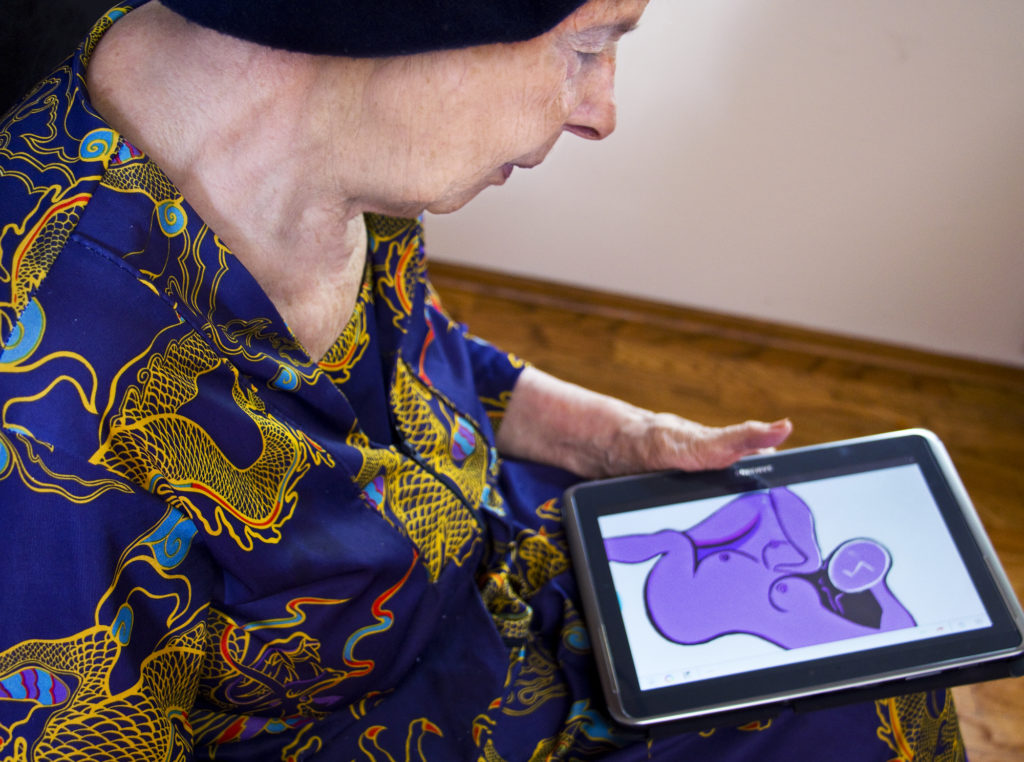
Lenore Simon at work. Photo by Liz Lopes
Lenore Simon: “The human form is something we are most familiar with. It is also a form that was stressed significantly during art studies from the ancients to modern times.Having had the good fortune to work from live models during my earliest days in high school the human form was the most often touched up subject matter.I can still recall the powerful image of The Winged Victory when I entered the Metropolitan Museum with my school mates during frequent field trips. A more abstract presentation of nudes in the Museum of Modern Art’s Garden provided other options for depicting the human form. Unlike objects set-up for still life studies only the human form has the capacity to express both motion and emotion which makes it a preferred subject from this artist’s perspective.” – Simon

Linda Litteral working in studio
Linda Litteral: “I explore the female form. I think that the body remembers and memory is what I play with in my sculpture. We identify with our form, so it is easy to communicate with the female body. I can address women’s experience, and childhood experience with the body.”
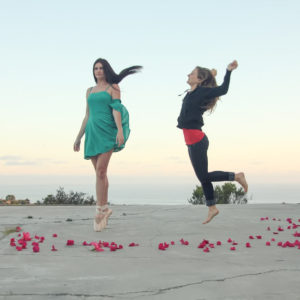
Lucia Ferreria
Lucia Ferreria: “In this particular series, Human/Nature, I explore our connect disconnect to our bodies and our surroundings. Nowadays, we seem to see our bodies as a machine that serves us in our life purposes. We seem to forget that as a living organism, we need to respect it’s natural cycles. In this series, I used my own body as a way to reclaim it and accept it for what it is, living matter.” – Ferreria
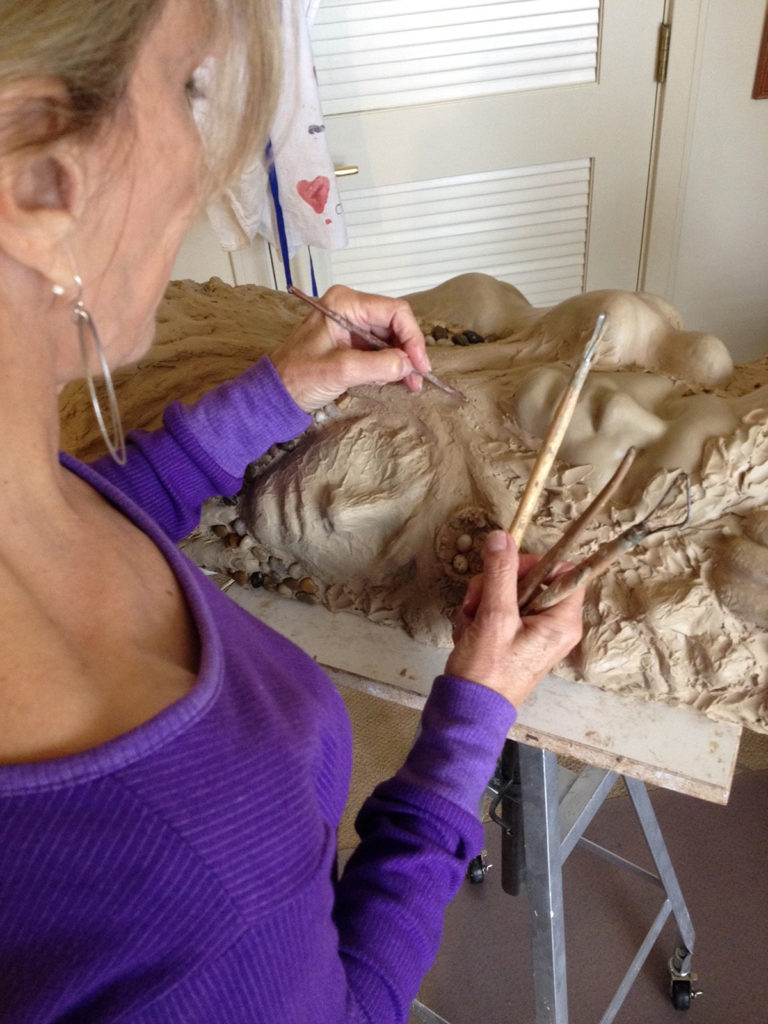
Maidy Morhous sculpting in studio
Maidy Morhous: “My artwork is embedded in social critique, political and cultural issues. The resistance to the oppression of socially inscribed narratives and socially dominating practice presented sublimely to the viewer and open to interpretation.
These themes are often presented by using the human form to express suppression and the social issues affecting the world. The use of a crème marbleized patina establishes a dream-like surreal quality, suggesting notions of purity and safety, as well as a modern look to the sculptures. I see my work as relating collectively rather than as individualistic; the embodiment of feelings and emotions. In this way, my artwork is meant to be symbolic rather than representative.
Art is a form of communication between the artist and the viewer. Art is about vision, and how that vision is expressed is what can create a strong emotional pull for the observer. The human body is essential to our understanding facets of identity; such as sexuality, race, and ethnicity, and I believe the human form best expresses the theme of socially inscribed narratives.” – Morhous
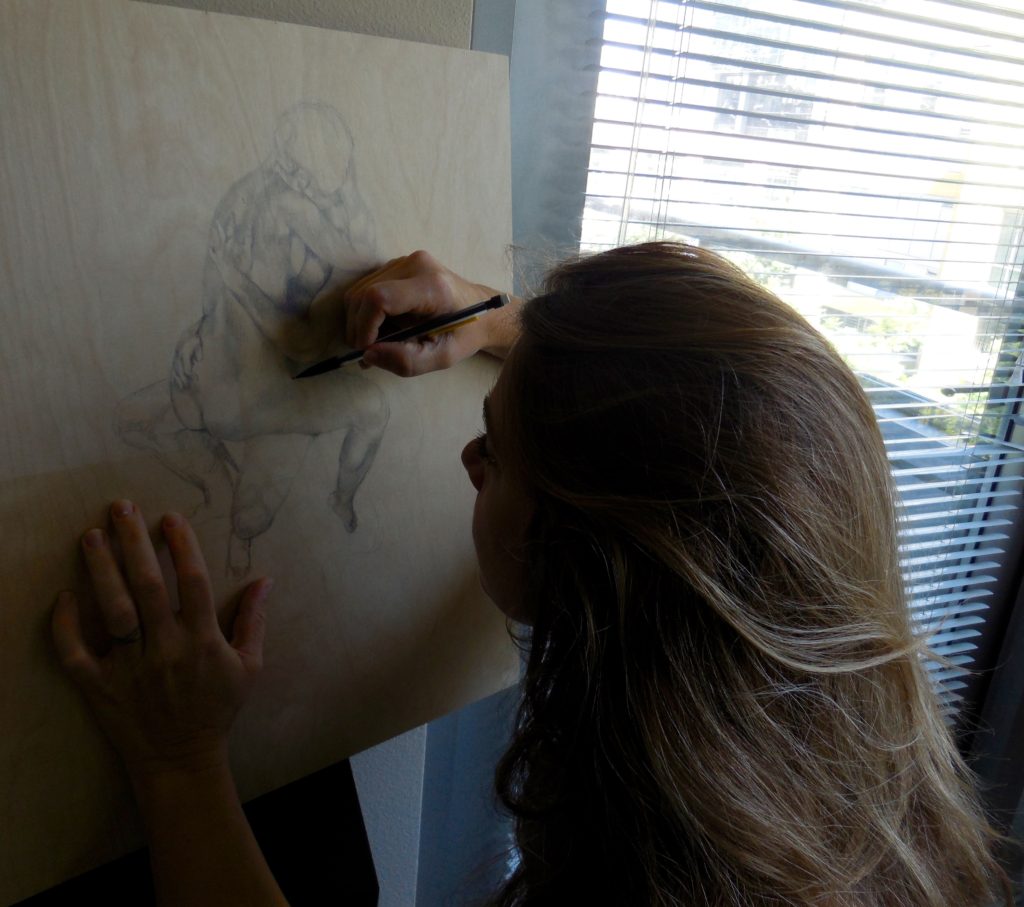
Michelle Ferrera at work
Michelle Ferrera: “It’s almost impossible to not have the human form portrayed in my work. For me, drawing the human form is the way I feel we communicate best, how I personally connect with myself and others. Working on wood became another mirror other than my journal that captures raw feeling, layers of skin flawed and beautiful, unique and individual, a piece of Art in itself. The importance of the nakedness in both material and subject matter is the vulnerability that leaves room for nothing but truth and honesty. Most of the forms I draw in each piece are self portraits. And if I’m not drawing out my own experiences, drawing the lives of others keeps me connected to the community and world we live in.” – Ferrera
Neal and Tiffany Bociek: “I choose to explore the figure because for me (and this is not speaking for Neal) it has something I have always done. When I was 13, I found an anatomy and figure drawing book on my father’s library shelf that he had purchased many years ago at a library auction. I remember looking through the first couple of pages and loved looking at the gesture drawings and all the different motions a human can make. I became fascinated with the tendons and the muscles that clung to our bones to makes our various facial features. I enjoyed the process of trying to make my flat two dimensional paper drawing into something that had life and three dimensionality to it. I took that book with me everywhere— on many a vacation, to school (and then immediately got in trouble for having a book with nudes in it), and pouring over it after school was out for the day. It became a quest to achieve understading of movement and proportion and simply enough I just began practicing drawing those images. From then, I have branched off into new and different paths but the figure always seems to pop up in my works. I think the figure is such a beautiful thing, it can be ever changing and so different and yet we all poses one.
I can not speak for Neal as far as the figure. I know a lot of his process when it comes to sculpture is letting the materials speak to him—so for this piece “Lady Bitsee” we had played with a few different ideas and we both giggled because we knew it was somehow going to become a woman but what she looked like or what the end result was; the materials hadn’t quite revealed themselves yet. We spent a lot of time in the shop looking at proportion and material choices.” – Tiffany Bociek
Ryan Thomas: “As a figurative artist, I like to focus on the emotional connection between the painting and the viewer. I feel that this connection exists most extraordinarily between individuals and if I can express that the figure in my painting is real, emotion can be transferred between the painting and the viewer.” -Thomas
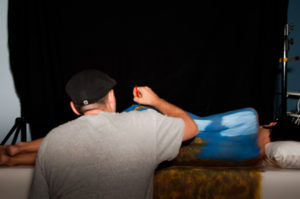
Sean Selfridge painting “Top Heavy” on model
Sean Selfridge: “I paint landscapes on people for two main reasons. One first is to show that not every nude body has to be sexual, it is the most natural way we could be. The second is the challenge of painting on a curved surface.” – Selfridge
Stephanie Clair: “What I start with when I paint the human form- Each painting has a feeling; each feeling tells a story. Her eyes in the paintings allow the viewer to reach in and let you connect. She feels they are the windows to ones soul. She paints the body as a reflection of the soul, an extension of the beauty found in all living things.” – Clair

